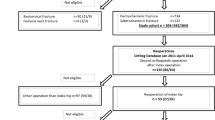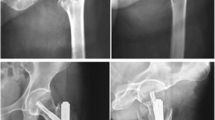Abstract
Introduction
Pertrochanteric fractures of the proximal femur should be treated surgically, unless the medical condition of the patient does not allow it. Currently, there are two ways to fix these fractures; either with a sliding hip screw or with an intramedullary nail. However, there is much debate over which implant is the best for pertrochanteric fracture fixation. The sliding hip screw has been used over time with good clinical results. While it was true that with first generation intramedullary nails the risk of complications was higher, there is evidence supporting the superiority of intramedullary nails in these fractures when compared with sliding hip screws. This evidence is based on the good clinical results and fewer complications, due to an improvement in the design of the implants and surgical technique used by surgeons. In stable fractures, despite the method chosen for fixation, obtaining a good reduction prior to placing the implant is the most important factor that can be controlled by the surgeon. In stable fractures the surgeon experience is a strong factor to account for when choosing the type of implant. Clearly there are fracture patterns (reverse oblique and subtrochanteric extension) that benefit from the use of intramedullary devices due to the high risk of failure if plates are used.
Conclusion
It is very important that the surgeon identifies these fractures, so the type of fixation device which is chosen achieves the greatest stability possible. The aim of this paper is not to convince the surgeon about using intramedullary nails, but highlight the potential benefits intramedullary nailing has when compared with the use of extramedullary devices.





Similar content being viewed by others
References
Ahrengart L, Törnkvist H, Fornander P, et al. A randomized study of the compression hip screw and gamma nail in 426 fractures. Clin Orthop Relat Res. 2002;401:209–22.
Utrilla AL, Reiq JS, Munoz FM, et al. Trochanteric gamma nail and compression hip screw for trochanteric fractures: a randomized, prospective, comparative study in 210 elderly patients with a new design of the Gamma nail. J Orthop Trauma. 2005;19:229–33.
Lubovsky O, Liebergall M, Mattan Y, et al. Early diagnosis of occult hip fractures: MRI versus CT scan. Injury. 2005;36:788–92.
Quinn SF, McCarthy JL. Prospective evaluation of patients with suspected hip fracture and indeterminate radiographs: use of T1-weighted MR images. Radiology. 1993;187:469–71.
Evans EM. The treatment of trochanteric fractures of the femur. J Bone Jt Surg Br. 1949;31:190–203.
Jin WJ, Dai LY, Cui YM, et al. Reliability of classification systems for intertrochanteric fractures of the proximal femur in experienced orthopaedic surgeons. Injury. 2005;36:858–61.
Sherk HH, Foster MD. Hip fractures: condylocephalic rod versus compression screw. Clin Orthop Relat Res. 1985;192:255–9.
Parker MJ, Pryor GA. Gamma versus DHS nailing for extracapsular femoral fractures: meta-analysis of ten randomised trials. Int Orthop. 1996;20:163–8.
Min WK, Kim SY, Kim TK, Lee KB, Cho MR, Ha YC, Koo KH. Proximal femoral nail for the treatment of reverse obliquity intertrochanteric fractures compared with gamma nail. J Trauma. 2007;63(5):1054–60.
Dall’Oca C, Maluta T. Cement augmentation of intertrochanteric fractures stabilised with intramedullary nailing. Injury. 2010;41(11):1150–5.
Fensky F, Nüchtern JV, Kolb JP, Huber S, Rupprecht M, Jauch SY, Sellenschloh K, Püschel K, Morlock MM, Rueger JM, Lehmann W. Cement augmentation of the proximal femoral nail antirotation for the treatment of osteoporotic pertrochanteric fractures–a biomechanical cadaver study. Injury. 2013;44(6):802–7.
Hoffmann S, Paetzold R, Stephan D, Püschel K, Buehren V, Augat P. Biomechanical evaluation of interlocking lag screw design in intramedullary nailing of unstable pertrochanteric fractures. J Orthop Trauma. 2013;27(9):483–90.
D’Arrigo C, Carcangiu A, Perugia D, Scapellato S, Alonzo R, Frontini S, Ferretti A. Intertrochanteric fractures: comparison between two different locking nails. Int Orthop. 2012;36(12):2545–51.
Zuckerman JD, Skorron ML, Koval KJ, et al. Postoperative complications and mortality associated with operative delay in older patients who have a fracture of the hip. J Bone Jt Surg Am. 1995;77:1551–6.
Hardy DC, Descamps PY, Krallis P, et al. Use of an intramedullary hip-screw compared with a compression hip-screw with a plate for intertrochanteric femoral fractures: a prospective, randomized study of one hundred patients. J Bone Jt Surg Am. 1998;80:618–30.
Hou Z, Bowen TR, Irgit KS, Matzko ME, Andreychik CM, Horwitz DS, Smith WR. Treatment of pertrochanteric fractures (OTA 31-A1 and A2): long versus short cephalomedullary nailing. J Orthop Trauma. 2013;27(6):318–24.
Gadegone W, Lokhande V, Salphale Y, Ramteke A. Long proximal femoral nail in ipsilateral fractures proximal femur and shaft of femur. Indian J Orthop. 2013;47(3):272–7.
Pajarinen J, Lindahl J, Michelsson O, et al. Peritrochanteric femoral fractures treated with a dynamic hip screw or a proximal femoral nail: a randomised study comparing post-operative rehabilitation. J Bone Jt Surg Br. 2005;87:76–81.
del Prete F, Nizegorodcew T, Regazzoni P. Quantification of surgical trauma: comparison of conventional and minimally invasive surgical techniques for pertrochanteric fracture surgery based on markers of inflammation (interleukins). J Orthop Traumatol. 2012;13(3):125–30.
Baumgaertner MR, Curtin SL, Lindskog DM. Intramedullary versus extramedullary fixation for the treatment of intertrochanteric hip fractures. Clin Orthop Relat Res. 1998;348:87–94.
Bhandari M, Schemitsch E, Jönsson A, Zlowodzki M, Haidukewych GJ. Gamma nails revisited: gamma nails versus compression hip screws in the management of intertrochanteric fractures of the hip: a meta-analysis. J Orthop Trauma. 2009;23(6):460–4.
Bartonicek I, Dousa P. Prospective randomized controlled trial of an intramedullary nail versus dynamic screw and plate of intertrochanteric fractures of the femur. J Orthop Trauma. 2002;16:363–4.
Leung KS, So WS, Shen WY, Hui PW. Gamma nails and dynamic hip screws for peritrochanteric fractures: a randomized prospective study in elderly patients. J Bone Jt Surg Br. 1992;74:345–51.
Im GI, Shin YW, Song YJ. Potentially unstable intertrochanteric fractures. J Orthop Trauma. 2005;19:5–9.
Kaufer H. Mechanics of the treatment of hip injuries. Clin Orthop Relat Res. 1980;146:53–61.
Conflict of interest
Santiago Ponce, Martin Laird and James Waddell declare that they have no conflict of interest.
Author information
Authors and Affiliations
Corresponding author
Rights and permissions
About this article
Cite this article
Ponce, S.J., Laird, M.P. & Waddell, J.P. Intramedullary nailing in pertrochanteric fractures of the proximal femur. Eur J Trauma Emerg Surg 40, 241–247 (2014). https://doi.org/10.1007/s00068-013-0371-6
Received:
Accepted:
Published:
Issue Date:
DOI: https://doi.org/10.1007/s00068-013-0371-6




